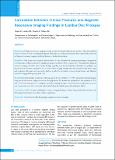Please use this identifier to cite or link to this item:
https://hdl.handle.net/20.500.14356/1698| Title: | Correlation between Clinical Features and Magnetic Resonance Imaging Findings in Lumbar Disc Prolapse |
| Authors: | Thapa, S S Lakhey, R B Sharma, P Pokhrel, R K |
| Citation: | ThapaS. S., LakheyR. B., SharmaP., & PokhrelR. K. (2016). Correlation between Clinical Features and Magnetic Resonance Imaging Findings in Lumbar Disc Prolapse. Journal of Nepal Health Research Council, 14(2). https://doi.org/10.33314/jnhrc.v14i2.794 |
| Issue Date: | 2016 |
| Publisher: | Nepal Health Research Council |
| Article Type: | Original Article |
| Keywords: | Correlation Lumbar disc prolapse Magnetic resonance imaging |
| Series/Report no.: | May-Aug, 2016;794 |
| Abstract: | Abstract Background: Magnetic resonance imaging is routinely done for diagnosis of lumbar disc prolapse. Many abnormalities of disc are observed even in asymptomatic patient.This study was conducted tocorrelate these abnormalities observed on Magnetic resonance imaging and clinical features of lumbar disc prolapse. Methods: A This prospective analytical study includes 57 cases of lumbar disc prolapse presenting to Department of Orthopedics, Tribhuvan University Teaching Hospital from March 2011 to August 2012. All patientshad Magnetic resonance imaging of lumbar spine and the findings regarding type, level and position of lumbar disc prolapse, any neural canal or foraminal compromise was recorded. These imaging findings were then correlated with clinical signs and symptoms. Chi-square test was used to find out p-value for correlation between clinical features and Magnetic resonance imaging findings using SPSS 17.0. Results: This study included 57 patients, with mean age 36.8 years. Of them 41(71.9%) patients had radicular leg pain along specific dermatome. Magnetic resonance imaging showed 104 lumbar disc prolapselevel. Disc prolapse at L4-L5 and L5-S1 level constituted 85.5%.Magnetic resonance imaging findings of neural foramina compromise and nerve root compression were fairly correlated withclinical findings of radicular pain and neurological deficit. Conclusions: Clinical features and Magnetic resonance imaging findings of lumbar discprolasehad faircorrelation, but all imaging abnormalities do not have a clinical significance. Keywords: Correlation; lumbar disc prolapse; magnetic resonance imaging. |
| Description: | Original Article |
| URI: | http://103.69.126.140:8080/handle/20.500.14356/1698 |
| ISSN: | Print ISSN: 1727-5482; Online ISSN: 1999-6217 |
| Appears in Collections: | Vol. 14 No. 2 Issue 33 May-Aug 2016 |
Files in This Item:
| File | Description | Size | Format | |
|---|---|---|---|---|
| 794-Article Text-1471-2-10-20170528.pdf | Fulltext Download | 175.94 kB | Adobe PDF |  View/Open |
Items in DSpace are protected by copyright, with all rights reserved, unless otherwise indicated.
